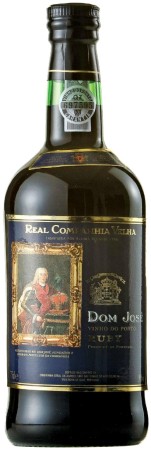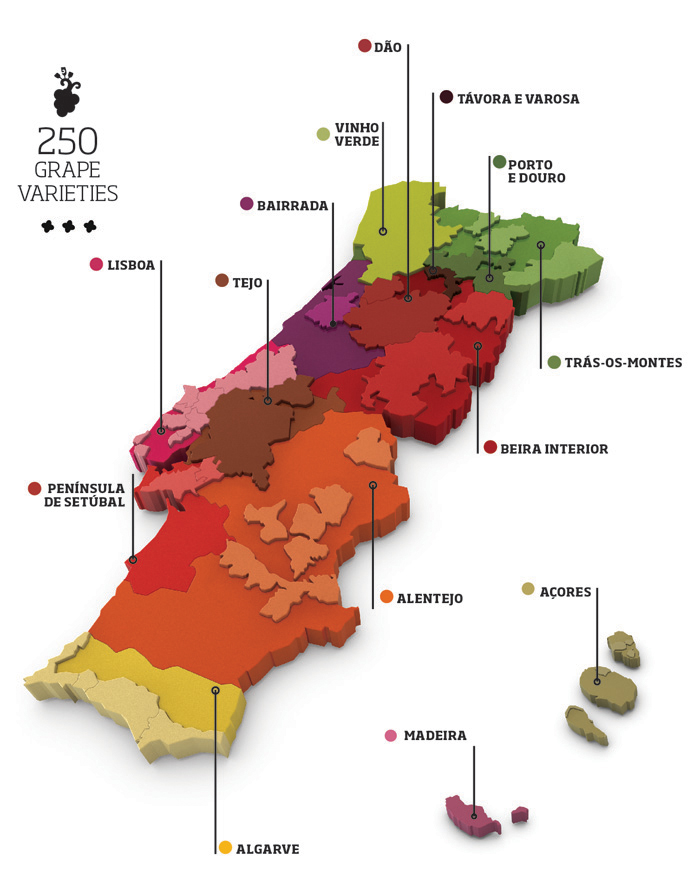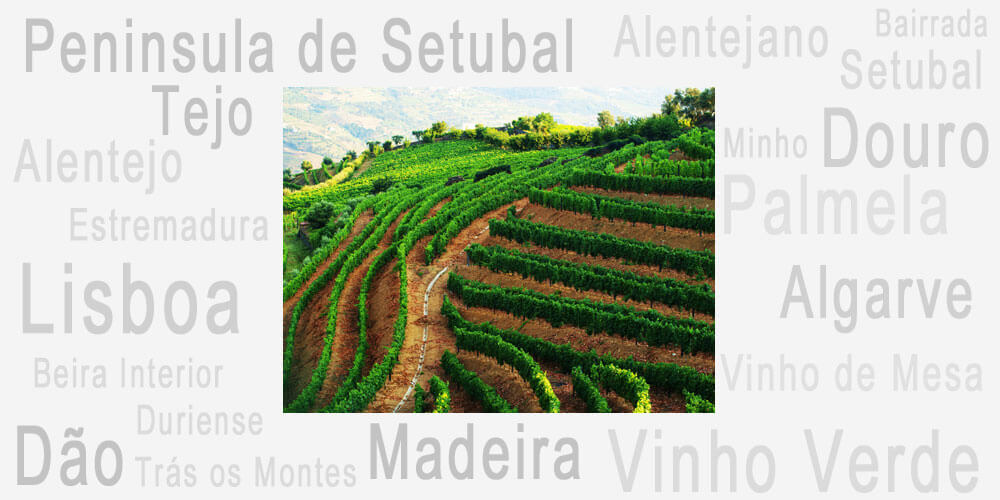A
B
D
E
L
M
P
S
T
V

Muros Antigos Alvarinho 2023
- White wine
- dry
- 2023
- Portugal - Vinho Verde
- Alvarinho
- Year of birth 2018: Robert Parker: 89 points
- Year 2018: Revista de Vinhos: 17 points
Ready to ship today,
Delivery time appr. 1-3 workdays

Cartuxa Colheita Tinto 2020
- Red wine
- dry
- 2020
- Portugal - Alentejo
- Alicante Bouschet, Aragonez, Diverse Rebsorten, Trincadeira
- Mundus Vini 2019: Gold medal
Ready to ship today,
Delivery time appr. 1-3 workdays

EA Rosé 2023
- rosé wine
- dry
- 2023
- Portugal - Alentejo
- Aragonez, Shiraz/Syrah, Touriga Nacional, Castelão
Ready to ship today,
Delivery time appr. 1-3 workdays

EA Reserva Tinto 2021
- Red wine
- dry
- 2021
- Portugal - Alentejo
- Alicante Bouschet, Aragonez, Shiraz/Syrah, Touriga Nacional
Ready to ship today,
Delivery time appr. 1-3 workdays

Terra d'Alter Verdelho 2023
- White wine
- dry
- 2023
- Portugal - Alentejano
- Verdelho
Ready to ship today,
Delivery time appr. 1-3 workdays

Dom Jose Ruby Porto
- port wine
- sweet
- no vintage
- Portugal - Porto
- Tinta Roriz, Touriga Franca, Touriga Nacional
Ready to ship today,
Delivery time appr. 1-3 workdays

Taylor's Chip Dry Port
- port wine
- off dry
- no vintage
- Portugal - Porto
- Diverse Rebsorten
Ready to ship today,
Delivery time appr. 1-3 workdays

Fonseca Porto Siroco Dry White
- port wine
- sweet
- no vintage
- Portugal - Douro
- Arinto, Gouvelho, Malvasia Fina, Rabigato, Viosinho
Ready to ship today,
Delivery time appr. 1-3 workdays

Quinta de S. José Flor de S. José Reserva...
- White wine
- dry
- 2018
- Portugal - Douro
- Alte Rebsorten, Gouvelho, Rabigato
Ready to ship today,
Delivery time appr. 1-3 workdays

Quinta Nova Vintage Porto 2002
- port wine
- sweet
- 2002
- Portugal - Douro
- Alte Rebsorten, Diverse Rebsorten
- Wine Spectator 2020: 93 points
- Robert Parker 2019: 96-98 points
- Revista Grandes Escolhas 2019: 18 points
- Revista de Vinhos 2019: 17.5 points
Ready to ship today,
Delivery time appr. 1-3 workdays

Terras de Felgueiras Alvarinho
- White wine
- dry
- no vintage
- Portugal - Vinho Verde
- Alvarinho
Ready to ship today,
Delivery time appr. 1-3 workdays

Van Zellers VZ Late Bottled Vintage Porto 2016
- port wine
- sweet
- 2016
- Portugal - Douro
- Rufete, Sousão, Tinta Amarela, Tinta Barroca, Tinta Franca, Tinta Roriz, Touriga Franca, Touriga Nacional
Ready to ship today,
Delivery time appr. 1-3 workdays
More Information
26 Portuguese wine-growing areas and local characteristics
Today, Portugal is divided into five wine-growing zones with over 40 quality wine-growing areas. Of these, 26 wine-growing areas have the highest, so-called DOC status (Denominação de Origem Controlada), which corresponds to the Spanish DO or the French AOC system. The special thing about Portual's wines, however, is that they are made mainly from indigenous, so-called autochthonous grape varieties.
With the Colares there is also an exceedingly rare wine in Portugal, which is still cultivated with European vines with their roots in the sand north of Sintra in Colares near the Atlantic coast. The phylloxera, which destroyed almost all other European vines in the 19th century, could not survive in the sand.

Douro - First official appellation in Europe
The wine country Portugal is divided into different wine regions. The "inventor" of the first official wine region (appellation) in Europe was the Marquês de Pombal. In 1756, he had the borders of the wine-growing region on the Douro precisely marked out and officially marked with boundary stones. This was to guarantee the quality of the "Fortified Wines" from there. And indeed: Port and Madeira from the Douro are so well received in England that they displace still wines.
The Douro wine-growing region is now one of the best known internationally, especially for its excellent red wines. It was in the late 1970s that wineries like Ferreira and Niepoort ventured into the world of high-quality red wines.
Today, the steep slopes of the Douro are especially home to the old and traditionally kept vineyards. There, the "mixed set" is cultivated, for example, the grape varieties Tinta Roriz, Touriga Nacional and Castelão. They are traditionally cultivated, harvested and processed together. The cuvée is virtually "born" in the field and this is what makes the red wines of the Douro so diverse. In order to develop further, Portuguese winemakers also cultivate indigenous grape varieties purely and produce, for example, a slender, rather mineral white wine.
Terras de Cister - stronghold of sparkling wine
South of the Douro lies the small wine region of Terras de Cister. Here the Cistercians grew the first wine. The region is characterized by a very unique climate with very cool nights. The grapes therefore ripen later, but then stand for elegant and complex red and white wines. Their pronounced acidity also makes them excellent base wines for sparkling wines. Thus, the Terras de Cister produces some of the best sparkling wines in the country. Because sparkling wines have always been popular in the region, winemakers planted French grape varieties such as Chardonnay and Pinot Noir over 100 years ago. Further, the white varieties Malvasia Fina, Godelho and Cerceral are grown here, as well as red grape varieties such as Tempranillo/Aragonez, Touriga Nacional and Touriga Franca.
Wines from the Dão are an insider tip
The Dão wine region is surrounded by mountain ranges in the middle of Portugal. Because of its location, it is shielded from the influence of the Atlantic Ocean and also from the continental climate, it has its own microclimate. Summers are dry and warm, winters are very cold. Even in late summer, the nights cool down considerably, which allows the grapes, which are grown at altitudes between 400 and 500 meters on granite and slate soils, to ripen later.
From the Dão come elegant red wines with structure and complex aromas. The aromatically fine white wines are mainly made from Encruzado, Vercial and Malvasia grape varieties. The red wines are dominated by Touriga Nacional, Alfrocheiro and Aragones grape varieties. Wines from the Jaen variety, known in Spain as Mencía, from the Dão are considered an insider tip because of their elegance and complexity.
Beira Interior - a region rich in grape varieties
Southeast of the Dão, on the border with Spain, lies Beira Interior, a completely remote wine-growing region. Here, on the highest mountains, there is sometimes snow in winter. Due to the cooler climate, the season is shorter, which is reflected in the red wines as a strong fruit and also provides for strong tannins. These wines need a longer ripening period, but then convince with a lean body and fine minerality. They are true treasures that are created here in the Dão. The region is rich in its own grape varieties and yeasts used for centuries. Murufo, Bastardo, Alfrocheiro, Trincadeira and Touriga Nacional are the predominant red grape varieties, while Siria, Arinto and Malvasia dominate the white ones.
Beira Atlântico: Home of the Baga
In the small wine region of Beira Atlântico, international critics see the future hotspot of wine growing. Here, pure varietal red wines are made from the Baga grape. The classic Baga is a dense, tannic wine with a lot of acidity, which after an aging period of 10 to 20 years turns into an elegant, very structured red wine reminiscent of a Pinot Noir. The good acid structure of Baga also benefits the rose sparkling wines that come from here.
Lisboa - Wine diversity in a small area
South of Beira Atlântico lies the wine region Lisboa. The narrow strip of land of the cultivation area reaches to the gates of the Portuguese capital Lisbon. The wine region is very diverse. Near Colares, there is still a vineyard with root-left vines from Europe, which have survived phylloxera in the sandy soils. From their grapes are made wines with secret factor. The area is also known for sparkling and white wines made from the white grape variety Arinto. Its hallmark is a particularly fresh, mineral and dry body, which makes the wine a great companion to food. But Touriga Nacional and Touriga Franca also have their home here.
In the Lisboa growing region, however, well-known grape varieties such as Cabernet Sauvignon and Syrah or the French varieties Alenquer, Torres Vedras and Óbidos can now also be found. In the areas that face the Atlantic, vines grow from which light wines with low alcohol content, so-called Vinho Leve, and red wines with less fruit but more spice are produced.The areas that lack the wind of the Atlantic, but have a cool climate, offer the best conditions for aromatic white wines from Fernão Pires. Light and fresh red wines are also vinified here.
Special cuvées from the Tejo region
The Tejo wine region winds inland along the river of the same name. In the valley, the soils are sandy; in the higher elevations, clay, limestone or slate can be found. New vineyards are being planted here. In addition to the native grape varieties, Cabernet Sauvignon, Syrah, Sauvignon Blanc and Chardonnay are also found in the wine region. The red and white cuvée, in which autochthonous and French grape varieties are combined, are considered an insider tip.
Alentejo - Wines with full fruit
Below the Tagus River stretches the Alentejo region, which is characterized by wheat fields, olive groves and sunflower fields. It is also where the cork oaks grow, making the Alentejo the leading cork region to this day. The entire region is on the move. Private wineries as well as winegrowers' cooperatives have invested in cellar technology and new vineyards. The red wines from the Alentejo are mainly cuvées from the indigenous grape varieties Aragones, Alicante Bouschet, Castelão and Trincadeira. They are characterized by a full body and lots of fruit, and by an acid-sweet balance. The white wines are made from Arinto, Fernão Pires and Antão Vaz grapes. Whether white or red - drinking pleasure at an excellent price-pleasure ratio is guaranteed.
Fine liqueur wines from Setúbal
South of Lisbon is the wine region Peninsula de Setúbal. From there comes the liqueur wine Moscatel, which is internationally known. These wines have a generous sweetness and an alcohol content of at least 18 percent by volume. They must be aged in barrels for at least 18 months. For the red wines from the Setúbal region, the Castelão grape is mainly used; more precisely, at least 67 percent of this grape variety must be found in the cuvée. The remaining 33 percent comes either from autochthonous grape varieties such as Aragones and Trincadeira, or Syrah or Cabernet Sauvignon. The sandy soils produce fruit-driven wines with ripe tannins that become significantly more complex with age.
Fresh white wines from the Algarve
In the Algarve, the coastal region on the Atlantic Ocean, in the very south of Portugal, are the four growing areas of Lagoa, Lagos, Portimão and Tavira. Due to the proximity of the Atlantic Ocean, the nights are cool and the soil is rather dry from the wind. The region has its own unique grape variety called "Negra Mole". It is the most planted variety on the south coast in the 20th century and the new generation of producers and oenologists have rediscovered for themselves the vine, which is one of the oldest grape varieties in the country. Other national and international grape varieties continue to grow in the Algarve, producing red, rosé and white wines. The region is particularly known for its fresh, light and fruity white wine.
Special wines from the island of Madeira and the Azores
Special wines are produced in the Atlantic Ocean on the flower island of Madeira and on the Azores and the island of Pico. Madeira, famous all over the world, is one of the best of its kind as a fortified wine. White wines from the island of Pico, which belongs to the Azores, are perhaps not yet so well known, but are an insider tip. The Godelho grape variety is cultivated with enormous effort in vineyards surrounded by stone walls. It is an aromatic wonder and captivates with notes of white fruit, stone and smoke, which are due to the volcanic soil of the island. The Atlantic weather brings a slight saltiness to the wine.

